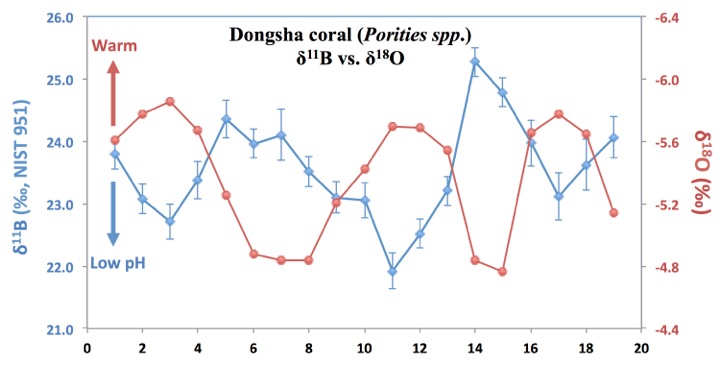東沙珊瑚礁生物地球化學記錄與環境條件對比研究:重建人類活動在南海的影響
Comparative study between the biogeochemical records in Dongsha coral reef and environmental factors: Reconstructing the anthropogenic impact in the South China Sea
Over the past 250 years, atmospheric CO2 levels increase by nearly 40%, from pre-industrial levels of ~280 ppmv to ~400 ppmv in 2014. An increase in oceanic pCO2 is a predictable consequence of rising atmospheric CO2 over the next half of century1, which results in reduced pH and lower calcium carbonate saturation state in shallow oceanic environments. A substantial decrease in oceanic pH has raised much concern for the physiological and ecological response of marine calcifying organisms. However, the response of calcifying organisms to accelerating effects of declining seawater pH is still poorly constrained and uncertainties arise when involving the combined effects of climate change and ocean acidification (OA) on these biogenic calcifiers in natural environments. Insights into these issues can be gained by developing reliable paleo-proxies for marine carbonate chemistry. The boron (B) isotopic composition of marine biogenic carbonates is considered to be the most reliable proxy for seawater pH2,3. In order to evaluate if the coral reefs around the Taiwan islands are influenced by OA or other environmental changes, we conducted an in-situ calibration of the δ11B in coral skeleton (massive Porities spp.) against ambient seawater pH at their growth locations in Dongsha Atoll. Our results (2010-2013) show that low seawater pH (low δ11B value) was recorded in coral skeleton during the summer and high seawater pH (high
δ11B value) during the winter, consistent with the instrumental pH records at Dongsha Atoll. This suggests that coralline δ11B can faithfully reflect the seawater pH variation in our study site, and thus has a great potential to further elucidate how OA influences the coral reef ecosystem and the response of calcifying organisms in the Dongsha Atoll under climatic and environmental changes.
在過去的兩百五十年間,大氣二氧化碳濃度從工業革命前的280 ppmv 迅速增加至400 ppmv(2014 年),增加了將近40%。海洋中溶解的二氧化碳濃度也可預期地將於下一個世紀中大幅增加,進而導致海水pH 值和海洋碳酸鈣飽和程度的降低1。雖然國際上許多的研究已經注意並報導海洋酸化對海洋中鈣化生物於生理及生態上都有重大的影響,然而仍有許多具爭議之處,特別是當海洋酸化及其他氣候變遷共同影響的自然環境。為了進一步瞭解海洋酸化的影響,可靠的海洋碳酸鹽系統代用指標發展是必要的。生物性碳酸鈣的殼體或骨骼中硼同位素是目前被認為最佳的海水pH 值代用指標2,3,因此本研究團隊的主要目標為發展高精準硼同位素質譜分析術及校正東沙環礁內珊瑚骨骼硼同位素與海水的關係,作為未來重建東沙環礁附近海水pH 值變化的主要工具及參考依據。我們的研究發現(2010-2013 年間),珊瑚骨骼硼同位素所記錄的夏季海水pH 值較冬季時低。此結果與近期於東沙環礁內佈放的pH 探針所記錄到
的變化相近,顯示東沙環礁內珊瑚骨骼硼同位素可忠實反映周圍海水pH 值的變化,未來將可用於探討海洋酸化對東沙珊瑚礁生態系統的影響,以及海洋中鈣化生物如何反映目前所遭遇的氣候及環境變遷。
1. Feely, R. A. et al., Impact of anthropogenic CO2 on the CaCO3 system in the oceans. Science 305, 362-366 (2004).
2. Hönisch, B. et al., Assessing scleractinian corals as recorders for paleo-pH: empirical calibration and vital effects. GCA 68, 3675-3685 (2004)
3. Anagnostou, E. et al., Evaluation of boron isotope ratio as a pH proxy in the deep-sea coral Desmophyllum dianthus: Evidence of physiological pH adjustment. EPSL 249-350, 251-260 (2012).

